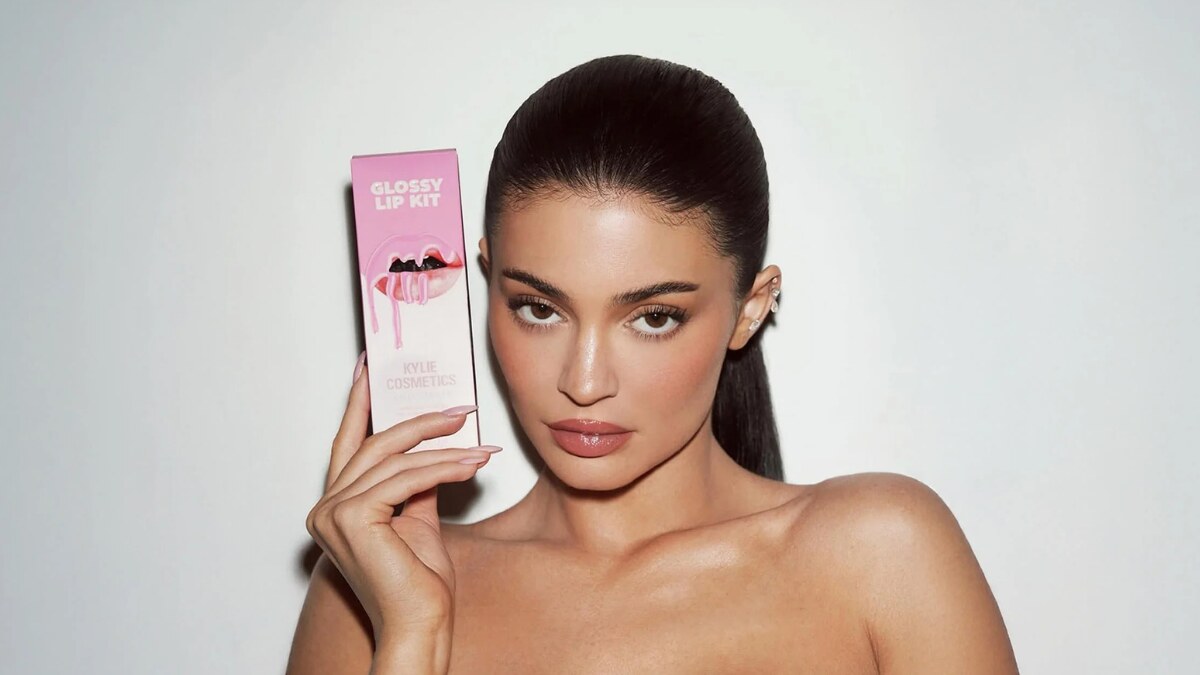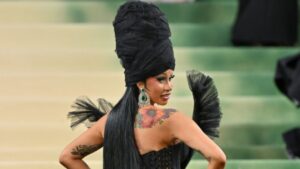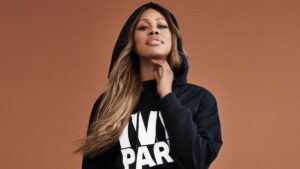When Kylie Jenner first appeared on television, she was the youngest sibling in a family already steeped in fame. To most viewers, she was simply the quiet teenager in the background of Keeping Up with the Kardashians — more a side character in the Kardashian universe than a headline-maker in her own right. Few would have predicted that this same girl, often overshadowed by her older sisters, would eventually become the architect of one of the most recognizable beauty brands in the world.
The leap from reality TV personality to global business mogul wasn’t just a matter of celebrity leverage; it marked a fundamental shift in how beauty could be marketed, sold, and experienced. Kylie didn’t rely on glossy magazine spreads or department store counters. Instead, she turned Instagram into her stage, her storefront, and her megaphone, building a direct-to-consumer empire that resonated with millions of young fans who saw themselves reflected in her image.
Her transformation mattered because it wasn’t just personal — it reshaped an industry. By channeling authenticity, scarcity-driven hype, and the power of digital community, Kylie Jenner proved that a teenager with influence could rewrite the rules of beauty entrepreneurship.
The Spark of an Idea — When Lip Kits Became a Movement
The Insecurity That Fueled Innovation
Before Kylie Jenner became a beauty mogul, she was a teenager navigating the same insecurities that define so many young women. Her lips — often scrutinized in the media — became both a point of self-consciousness and, eventually, the spark for her empire. When Kylie candidly admitted to using fillers, she shifted the conversation from whispered speculation to a moment of transparency. That honesty made her more relatable to her fans, many of whom wrestled with their insecurities about appearance.
Rather than hiding from criticism, Kylie leaned into it. The Lip Kit was born as a solution: a carefully crafted pairing of liner and liquid lipstick that gave her signature look to anyone who wanted it. In a culture obsessed with filters and flawless selfies, she turned vulnerability into innovation. By addressing a personal need, Kylie tapped into a universal desire for confidence, authenticity, and self-expression.
Scarcity Marketing Done Right
When Kylie’s first Lip Kits hit the market in 2015, they vanished almost instantly. Within minutes, fans flooded social media with frustration over empty carts and triumphant posts from those who managed to snag one. This wasn’t just a product launch — it was a viral product launch engineered around scarcity. By releasing small batches at unpredictable times, Kylie tapped into a deep vein of consumer psychology: the fear of missing out.
Each sellout amplified the frenzy, turning limited stock into proof of desirability. The buzz was self-perpetuating — the more people talked about not getting a Lip Kit, the more others wanted in. In the age of Instagram, where beauty trends spread at lightning speed, owning a Kylie Lip Kit became a badge of cultural participation. What began as a clever rollout strategy quickly snowballed into a cult-like following, cementing Kylie Cosmetics as a brand born from social buzz and exclusivity.
Digital-First Marketing — Instagram as the New Madison Avenue
Turning Followers into Buyers
Kylie Jenner didn’t just post on Instagram — she turned it into her primary storefront. With over a hundred million followers watching her every move, each selfie wearing a new shade of lipstick doubled as an irresistible sales pitch. Unlike traditional advertising, these posts felt personal, woven seamlessly into the flow of her daily life. When shoppable posts rolled out, Kylie Cosmetics became one of the most visible examples of social commerce in action, allowing fans to purchase directly from their feeds. By collapsing the distance between admiration and transaction, Kylie blurred the line between celebrity and brand. Her followers weren’t just watching her life unfold — they were actively buying into it.
Visual Branding and Storytelling
Kylie’s brand identity wasn’t built through billboards or glossy print ads — it was crafted in real time on Instagram. A single selfie wearing a new shade could spark weeks of conversation, while close-up swatches on her arm gave fans an intimate view of how products would look. Packaging design, from the dripping lip motif to bold color palettes, reinforced the sense of playful glamour that fans associated with her style. This visual consistency created a story: owning a Lip Kit meant stepping into Kylie’s world. In an industry once dominated by polished campaigns, Kylie proved that aesthetics and authentic storytelling could outshine traditional advertising and generate lasting consumer desire.
Influencer Ecosystem
Kylie’s rise wasn’t powered by her alone — it was amplified by an organic network of family and friends who acted as built-in brand ambassadors. When Kim, Khloé, or Kendall casually posted a Kylie Lip Kit, it created waves of earned media that no ad spend could buy. Beyond her famous siblings, Kylie tapped into a wider circle of friends and micro-influencers, who made the products feel accessible across different lifestyles and aesthetics. This peer endorsement strategy blurred the line between celebrity and everyday influence, creating a ripple effect that extended far beyond her following. What looked like casual support was, in reality, cultural amplification — a powerful example of influencer marketing in its purest form.
The Power of Scarcity, Exclusivity & Hype Cycles
Kylie Cosmetics didn’t just sell makeup — it sold moments. Every launch was designed like an event, with countdowns, surprise reveals, and limited stock that echoed the energy of sneaker drop culture. Fans weren’t just buying lipstick; they were racing against the clock, hoping to secure a piece of something rare. This scarcity wasn’t accidental — it was a deliberate strategy that tapped into consumer psychology, making ownership feel like a victory.
Seasonal collaborations added another layer of urgency. A Kylie x Holiday Collection or a Kylie x Kendall drop wasn’t just a new product; it was a cultural artifact with a built-in expiration date. Much like limited-edition sneakers or streetwear capsules, the scarcity created secondary markets, with resellers flipping Lip Kits at a markup.
For fans, buying wasn’t only about cosmetics — it was about belonging to an exclusive community. Each sold-out launch reaffirmed the brand’s desirability, while the cycle of hype kept audiences engaged and eager for the next reveal. By aligning beauty with the rhythms of drop culture, Kylie Cosmetics transformed makeup into more than a purchase: it became a chase, a status symbol, and a loyalty loop powered by anticipation.
Beyond the Numbers — The Coty Deal and Billion-Dollar Valuation
The Art of Timing
Kylie’s decision to sell a majority stake in Kylie Cosmetics to Coty in 2019 was as much about timing as it was about money. The brand was riding peak cultural relevance, with Lip Kits still synonymous with viral beauty trends and Kylie herself crowned the “youngest self-made billionaire.” Yet, market signals were shifting — competition in celebrity beauty was intensifying, and growth in direct-to-consumer brands was beginning to plateau. By striking the deal when valuations for digitally native brands were soaring, Kylie secured a billion-dollar exit at the crest of her influence, turning hype into lasting financial security.
What Coty Gained
For Coty, the acquisition wasn’t just about products — it was about relevance. The company, long anchored in legacy beauty names, had struggled to capture the attention of younger consumers. Kylie Cosmetics offered a direct pipeline to Gen Z and millennial buyers who lived online and discovered trends through social media. Beyond sales, Coty gained rare insight into social-first marketing: how to build buzz, leverage influencers, and turn followers into loyal customers. In contrast to Coty’s traditional reliance on department stores and print campaigns, Kylie represented a blueprint for the digital future that Coty desperately needed to adopt.
Control vs. Exit
By selling 51% of Kylie Cosmetics to Coty, Kylie surrendered majority ownership — and with it, a level of operational control. Yet the trade-off was strategic. She retained her role as the face and creative driver of the brand, ensuring that its identity stayed tied to her persona. In exchange, Coty took on the heavy lifting: global distribution, supply chain, and scaling infrastructure. For Kylie, the deal meant stepping back from day-to-day logistics while cashing in on the brand’s peak valuation. It was a textbook example of balancing exit strategy with long-term cultural influence.
My Close-Up View of the Kylie Effect
I remember stepping into a Kylie Cosmetics pop-up in Los Angeles, and the atmosphere felt more like a concert than a retail event. The line outside wrapped around the block, filled with teenagers in carefully styled outfits, phones in hand, ready to document every second. Inside, the shelves gleamed with rows of Lip Kits, each box adorned with the signature dripping lip logo that had already become iconic.
The energy was electric — shrieks when someone snagged the last shade of a coveted color, selfies taken against branded backdrops, fans clutching their purchases as if they were trophies. What struck me most wasn’t just the products, but the sense of belonging. Shoppers weren’t simply buying lipstick; they were buying into Kylie’s story, her aesthetic, her world.
Later that night, scrolling Instagram, I saw the same excitement ripple through my feed — swatches, unboxings, reviews — a digital echo of the in-person frenzy. It was a rare convergence: online hype materializing into real-world devotion. Experiencing it firsthand, I understood why Kylie Cosmetics wasn’t just a beauty brand. It was a cultural phenomenon, powered by emotion, identity, and the thrill of being part of something bigger than makeup.
How Kylie Stacks Up Against Other Celebrity Entrepreneurs
Rihanna’s Fenty — Inclusivity as a Brand Pillar
When Rihanna launched Fenty Beauty in 2017 with forty foundation shades, it reset the standard for what inclusivity in cosmetics should look like. Suddenly, the lack of options for deeper and undertoned undertones was no longer acceptable. Fenty’s success was built on the principle that beauty should serve everyone, and the industry scrambled to catch up. In contrast, Kylie Cosmetics leaned on trend-driven, hype-oriented strategies — capitalizing on viral lip colors, limited drops, and influencer amplification. Both approaches resonated, but in different ways: Kylie created urgency and aspiration, while Rihanna cultivated trust and representation. Together, they defined two poles of modern celebrity beauty: exclusivity through hype versus inclusivity through access.
Kim Kardashian’s SKKN — Luxury Positioning
Kim Kardashian took a different path when she launched SKKN by Kim, leaning into the world of luxury skincare. With sleek, minimalist packaging, high price points, and a focus on elevated routines, SKKN positioned itself closer to prestige spa products than viral makeup trends. The branding emphasized refinement and longevity, appealing to consumers who viewed skincare as an investment in self-care. Kylie Cosmetics, by contrast, thrived on accessibility and cultural buzz — bold colors, playful packaging, and limited-edition hype designed for quick sellouts. While Kylie captured the energy of digital-first beauty, Kim aimed to create a long-lasting prestige brand, illustrating how even within one family, strategies can diverge dramatically.
Selena Gomez’s Rare Beauty — Community & Wellness
Selena Gomez approached beauty with a mission far beyond makeup: to foster self-acceptance and support mental health. Rare Beauty’s campaigns emphasize ease, authenticity, and the message that beauty should enhance rather than transform. The brand invests in the Rare Impact Fund, dedicated to expanding mental health services, making purpose as integral as product. This ethos contrasts with Kylie Cosmetics’ aspirational glam, where the focus has been on trend-driven products and the allure of celebrity aesthetics. Rare Beauty resonates with consumers who crave relatability and a sense of community, while Kylie appeals to those drawn to hype, aspiration, and bold self-expression. Together, they reflect the diverse ways celebrity-led brands can capture loyalty.
Scaling Beyond Makeup — Fragrance, Skincare, and Lifestyle Expansion
After conquering color cosmetics, Kylie Jenner set her sights on building a broader product ecosystem. Kylie Skin launched in 2019, positioning itself as a natural extension of her beauty empire. With sleek pink packaging and approachable price points, the line gained traction among younger fans looking for accessible skincare. Kylie Baby, however, highlighted the risks of brand diversification. While authentic to her new role as a mother, the category didn’t spark the same viral momentum as Lip Kits, suggesting that not every lifestyle branding effort translates into mass excitement.

Fragrance collaborations, often tied to seasonal drops, also saw moderate success but lacked the cultural impact of her core makeup line. The takeaway for entrepreneurs is clear: expansion works best when it feels like a natural evolution of the brand’s DNA. Kylie’s strength lies in aspirational glam and trend-driven products; when she veers too far from that identity, consumer enthusiasm wanes. Still, her willingness to experiment reflects a valuable lesson in scaling — test categories boldly, but double down where your brand’s resonance is strongest. For Kylie, the Lip Kit magic may never be replicated, but it can be leveraged as the anchor of a diversified empire.
The Future of Kylie’s Brand in an AI and AR Beauty Era
AI Personalization
As beauty tech evolves, AI personalization could be the next frontier for Kylie Cosmetics. Imagine an app that scans a selfie to suggest the perfect foundation shade or curates lip colors based on skin tone, undertones, and even current trends. Competitors are already moving fast — Sephora’s Virtual Artist tool and L’Oréal’s acquisition of Modiface set the standard for AI-driven shade matching and product recommendations. For Kylie, whose brand thrives on direct-to-consumer intimacy, integrating AI would mean scaling her personal touch to millions. The technology could transform casual browsers into confident buyers, deepening loyalty through hyper-personalized shopping.
Augmented Reality Try-Ons & Virtual Retail
Kylie’s empire was born on Instagram, so it’s natural to imagine her brand thriving in augmented reality spaces. Already, AR try-on tools allow shoppers to swipe through lipstick shades or test eyeshadow palettes from their phones. If integrated directly into Instagram or TikTok, Kylie Cosmetics could replicate the excitement of swatching products in-store without physical inventory. Virtual pop-ups — from metaverse boutiques to limited-time digital events — could extend her drop culture into immersive spaces. Grounded in trends pioneered by L’Oréal’s Modiface and Gucci’s virtual sneakers, AR offers Kylie a way to merge her digital-first DNA with the next wave of beauty retail.
Global Expansion
For Kylie Cosmetics, the next growth frontier lies beyond the U.S. and Europe. Markets like India, Southeast Asia, and the Middle East are booming with young, beauty-savvy consumers who are highly engaged on social media. Yet global expansion isn’t just about distribution — it demands cultural adaptation. Shade ranges must reflect local skin tones, marketing should align with regional beauty ideals, and pricing strategies need to balance aspiration with accessibility. Collaborations with regional influencers could amplify authenticity. If executed thoughtfully, Kylie has the opportunity to transform her brand from a Western phenomenon into a truly global beauty powerhouse.
The Blueprint for Building a Modern Celebrity Empire
Kylie Jenner’s rise from reality TV teenager to beauty mogul underscores the new rules of celebrity entrepreneurship. Her story shows how authenticity, when paired with strategic timing, can transform a personal insecurity into a global product. By owning her narrative, leveraging digital-first marketing, and knowing when to partner with a legacy player like Coty, she built not just a cosmetics line but a modern blueprint for influence-driven business.
The larger lesson is that today’s celebrity empires aren’t powered by television ads or magazine covers, but by direct connections with audiences and the ability to turn cultural relevance into commerce. Kylie’s path illustrates the balance of hype and sustainability, creativity and ownership, vulnerability and ambition.
In many ways, her case is bigger than beauty: it’s a reflection of how fame, technology, and entrepreneurship now intertwine. Kylie didn’t just follow a trend — she helped define the era.
Mohit Wagh is the co-founder of The Graval with over 10 years of experience in SEO and content strategy. He specializes in crafting data-driven, authoritative content that blends cultural insight with digital growth.





6 thoughts on “How Kylie Jenner Built One of the Most Recognizable Beauty Brands in the World”